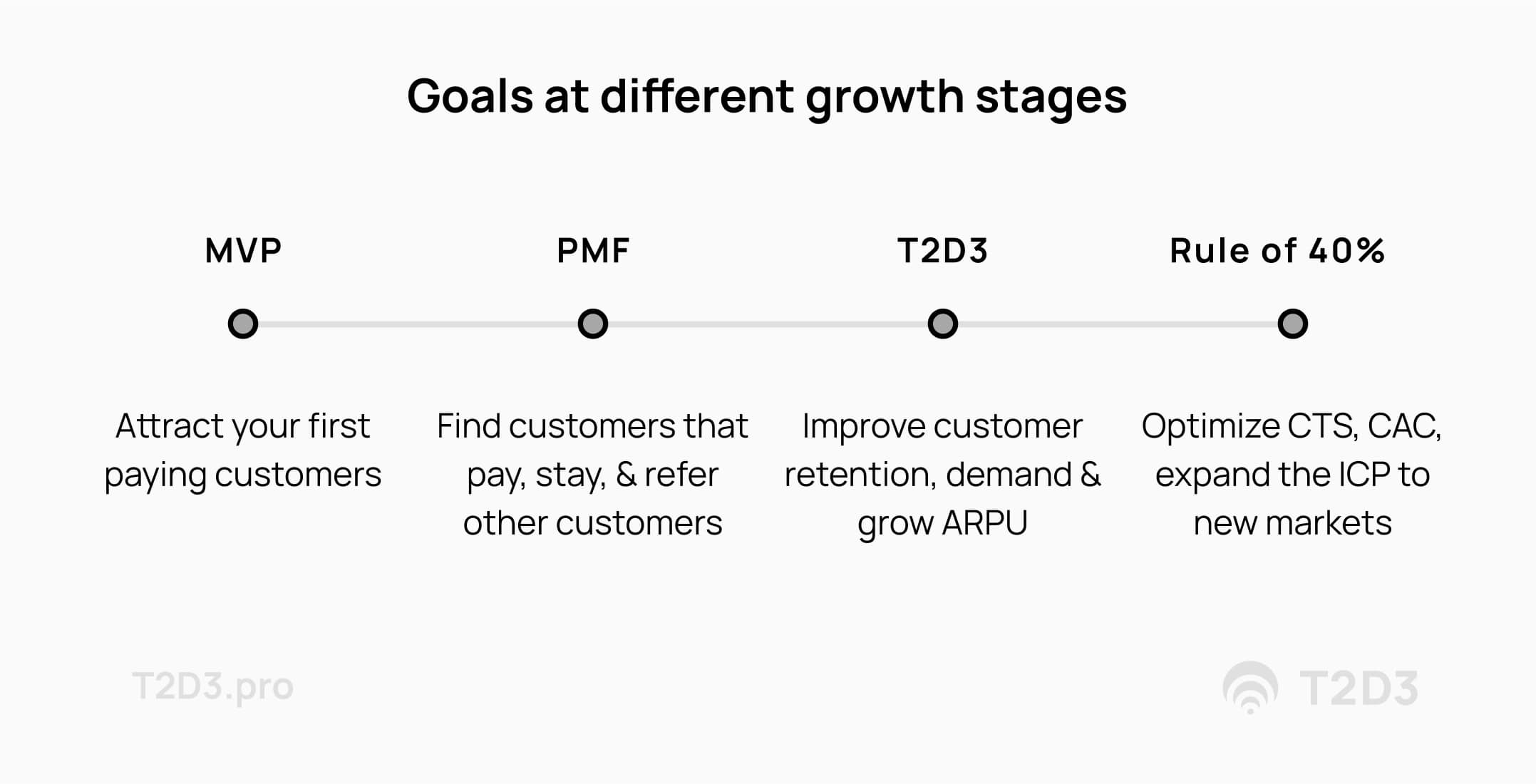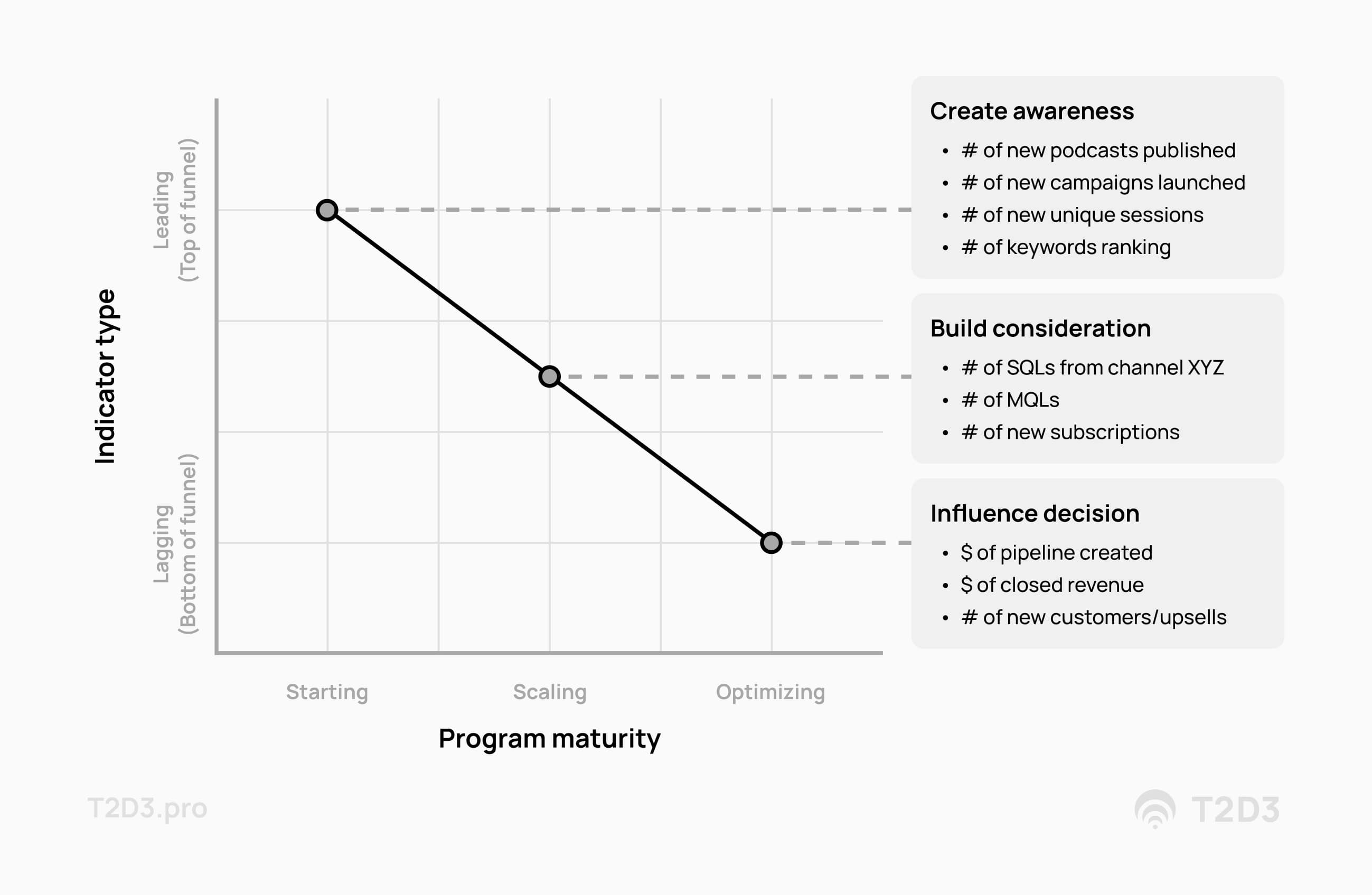More B2B SaaS marketing teams are adopting Objectives and Key Results (OKRs) to keep their attention focused on efforts that matter most (we hope you are too).
OKRs are a great tool. They allow you to measure progress against a strategic vision (objectives) using concrete outcomes (key results) and give your team members flexibility to make decisions about the specific activities they use to accomplish the goals. At Kalungi (outsourced marketing for B2B software companies), we use OKRs in every engagement to measure and manage the impact of marketing efforts.
But, not all OKRs are created equal. Installing generic OKRs can create a gap between your goals and what the team can deliver using the foundation that has (or hasn't) already been created.
A template for that help startups balance driving demand, sustainable growth, and good ROI.
READ ARTICLE
While every company should eventually get to the point where marketing is held accountable for lagging metrics like pipeline, trial conversions, net new revenue, retention, etc. that's not always where you should start. Unless your marketing function is well established, holding your team to bottom-of-funnel (BOFU) key results like those is a recipe for disappointment.
You need to pour the foundation before you build the house. And just as a company's goals will change with its growth stage (image below), your marketing team's OKRs should change with the sophistication of your team and the function.

The framework
Through creating hundreds of sets of OKRs through our work at Kalungi, we uncovered a few patterns that lend well to creating sustainable marketing flywheels.
Once you’ve picked your go-to-market strategy and defined the growth levers to use, you need to define realistic key results (KRs) customized to your own marketing department.
The best way to do this is by asking yourself how mature each marketing program is. Are you starting a new effort from scratch, or has the program been up and running for a year and shown some success?
The less mature (or new) a program is, the more your key results should reflect leading indicators (top-of-the-funnel/farther from revenue).
The more mature (or established) a program is, the more your key results should reflect lagging indicators (bottom-of-the-funnel/closer to revenue).
I've mapped this visually in the image below.

An example
Let’s consider a real-world example...
Let's assume your goal is to improve the revenue potential of your inbound channel. The growth lever you’ve chosen to support this goal is the creation and optimization of a blog.
So, which key results would you tie to this effort in the first quarter?
The number of comments? Time on-page for articles? Unique sessions from organic? MQLs? Did revenue attribute to specific articles?
It depends. How mature is your blog program right now? Your key results should vary greatly depending on whether your optimizing an established effort or creating a new one from scratch.
Using the same blog example from above, I've included three example sets of OKRs below—each assuming a different stage of maturity for the blog.
Example 1: A new program (starting)
For new efforts, key results should focus on leading indicators that prioritize completion and regular ‘shipment’ of work. When you’re building something from scratch, creating sustainable momentum is crucial.
If you're building a new blog from scratch, you can include a few activity-based key results and top-of-funnel (TOFU) metrics that support building a foundation and creating some awareness. Here, your quarterly OKR could be:
Objective: Build a sustainable organic search channel
- KR 1: Publish 12 new blog articles
- KR 2: Rank 5 high-priority keywords with 20+ monthly searches in the top 10 SERPs
- KR 3: Attribute 500 new website sessions to organic search
- KR 4: Interview 10 customers for content topics
Example 2: An existing program (scaling)
If you've already built a foundation, you should use middle-of-the-funnel (MOFU) metrics to measure success. In this stage, even though you might start seeing some bottom-of-funnel results, keep your attention on MOFU metrics. This will help your team stay focused on snowballing their momentum without accidentally incentivizing them to cut corners.
If you already have a small blog or content library that's responsible for some organic traffic, your key results should be aimed at turning 'viewers' into 'followers' who have some expressed level of intent. You also want to validate that they're the right kind of followers—ones that fit into your serviceable market. In this scenario, your quarterly OKR could be:
Objective: Build a sustainable organic search channel
- KR 1: Get 200 newsletter subscribers from organic search
- KR 2: Get 50 confirmed ICP-fit prospects who exchange information to download tools/resources on the blog
- KR 3: Attribute 15 MQLs to organic search
Example 3: A developed program (optimizing)
If you already have an inbound engine that reliably turns out both TOFU and MOFU results, your attention should shift to converting those results to qualified opportunities, pipeline and revenue.
You may need to be careful in this section—especially if have a product with a long sales cycle. If, on average, it takes you 6 months to close a deal from an MQL, using a revenue-based key result here doesn't set you up for success. There's little you can do to control the quality of an organic-search prospect that converted 6 months ago. In this situation, try to get your key results as low in the funnel as you can while still making them meaningful.
Using the blog example, your quarterly OKR could be:
Objective: Build a sustainable organic search channel
- KR 1: Generate 50 content-sourced free trials
- KR 2: Attribute 5 new sales opportunities to organic search
- KR 3: Create $XX,XXX in qualified new pipeline
Looking for more SaaS OKR examples?
If you're looking for more ideas to build your marketing OKRs, here's a more comprehensive list of 50+ OKR examples for B2B SaaS marketing leaders.
Don't forget: hurry, but don’t rush
Remember to take care when crafting your OKRs. OKRs should be drafted, reviewed, and validated. We like to share them across the company for visibility and accountability. Make sure to consider each initiative’s stage and your company’s overarching growth goals. Set yourself up to scrutinize success, and challenge your assumptions.